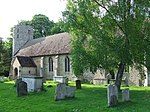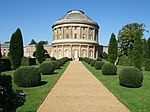Thingoe Hundred
Hundreds of Suffolk
Thingoe was a hundred of Suffolk, consisting of 31,850 acres (128.9 km2).One of the smaller hundreds of Suffolk, around 9 miles (14 km) wide and 11 miles (18 km) long, Thingoe contained the borough of Bury St Edmunds on its eastern border, though the town was considered a separate jurisdiction. The remainder of the hundred consisted of the land to the west of Bury St Edmunds. The River Lark rises in the hundred, flowing north to the River Little Ouse. The name derives from the words thing, a Norse word meaning "assembly", and howe, again Norse, meaning detached hill or mound.
Excerpt from the Wikipedia article Thingoe Hundred (License: CC BY-SA 3.0, Authors).Thingoe Hundred
Bury Road, West Suffolk The Saxhams
Geographical coordinates (GPS) Address Nearby Places Show on map
Geographical coordinates (GPS)
| Latitude | Longitude |
|---|---|
| N 52.25 ° | E 0.65 ° |
Address
Bury Road
IP29 5LF West Suffolk, The Saxhams
England, United Kingdom
Open on Google Maps








